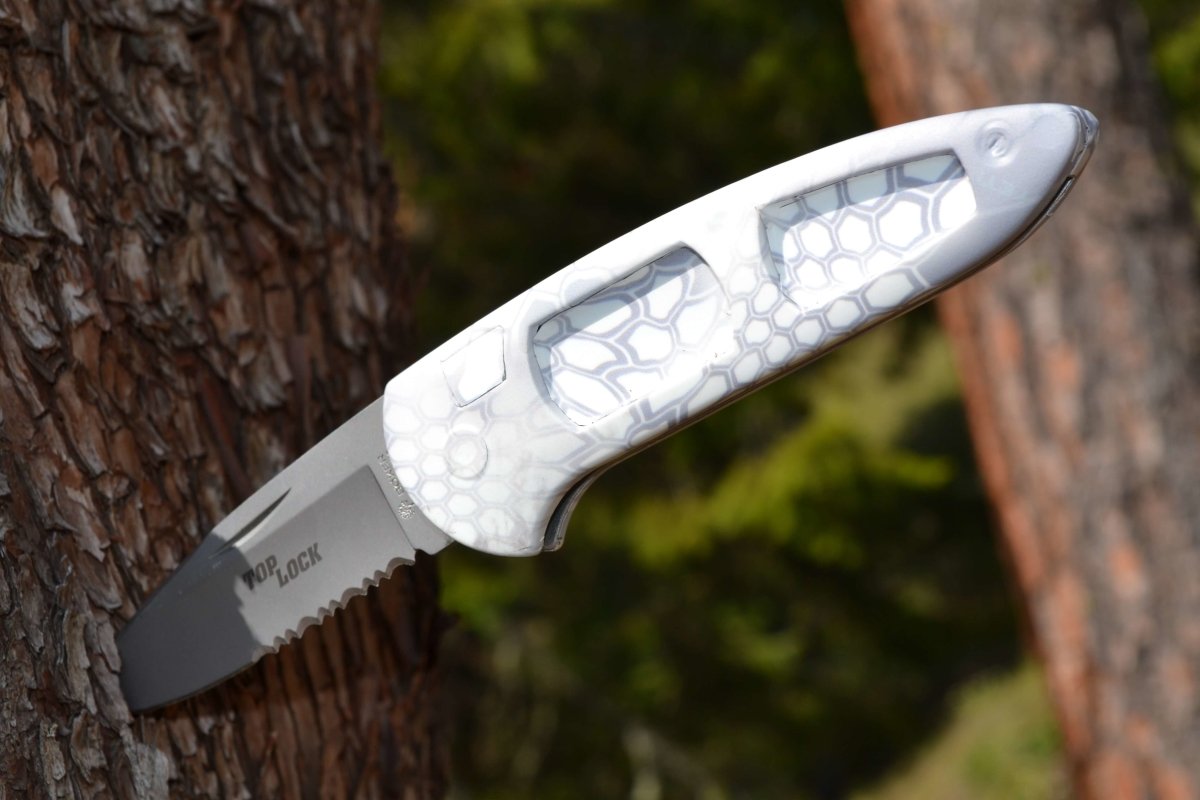Hunting Knives: The Ultimate Guide

Hunting is a multifaceted sport that requires the hunter to make big decisions about executing the kill. When deciding which tools to use, each hunter has plenty of options to choose from: Should I hunt with a gun or a bow? Is it better to hunt from a blind or a stand? Which camo is best for my hunt? Most of the time, there isn’t an easy answer because so much of what you’ll choose is based purely on personal preference and the type of game and environment.
But there’s one piece of gear every hunter and survivalist agrees is an absolute must no matter what type of hunting you’re doing: a proper hunting knife.
What makes a great hunting knife? With countless designs and shapes to choose from, it’s important to recognize what exactly you’re looking for. This is everything you need to know to choose the best hunting knife for your hunting needs.
What Makes a Quality Hunting Knife?
Every knife is created with a given purpose in mind. Constructing a hunting knife is a balancing act between flexibility and stiffness or rigidity.
When searching for a quality hunting knife, you want to look at four main components:
- Handle shape
- Blade shape
- Type of blade (fixed or folding)
- Blade flexibility
Handle Shape
There’s nothing worse than grabbing a knife that doesn’t fit your grip or feels uncomfortable when you use it. A knife that feels unwieldy can be dangerous to handle, causing slippage and fumbling. An uncomfortable handle could cause a loss of control, and a handle with “hot spots” or sharp edges and points could cause blistering or other injuries.
That’s why the handle shape of your hunting knife is one of the first components to address when choosing a hunting knife.
First, make sure that the handle is the correct length. A handle that is too short will dig into your hand when you’re trying to make cuts. A handle that is too long could get in the way or bump into objects (like bone, if undressing is what you’re using the knife for) while you’re trying to make cuts.
An ideal handle should fit comfortably within your closed grip. If you can, you should test the knife bolster or the handguard or groove between the handle and blade. This is designed to stop your hand from sliding forward down the blade. Some knives have a physical piece, while others have a slot for your index finger. It’s important to find the style you prefer.
Blade Shape
Blade shapes are less about comfort and more about the job at hand but keep personal preference and comfort in mind. There are many knives on the market, giving you the option to pick, choose, and find a blade you prefer.
Short blades are generally best for tight control, allowing you to move the blade with more minute hand movements. Longer blades, on the other hand, are usually designed for specific jobs that require more force.
Fish fillet knives are just one such type of long specialty blade. They are highly flexible and sharp to make it easy to follow the fish’s spine. Fillet knives are ideal for removing near-perfect fillets.
You may find a sharpened hook on the back of some hunting knives. This is called a gut hook and is specifically designed to cut down a deer or other big game's stomach to remove the guts while not penetrating too far and puncturing the intestines. A gut hook can be a great hunting knife feature for big game hunters.
Fixed or Folding Blades
When purchasing a new knife, you’ll need to choose between a fixed blade and a folding blade.
Folding blades have become popular due to their size and because they are ideal everyday carry knives. Folding blades are safer to carry because the knife’s blade folds into the handle, allowing it to be placed in a pocket or bag. While these knives are perfect for day-to-day living, they bring some disadvantages to the outdoors.
The primary issue with folding blades is cleaning and maintaining them. When cleaning game, the liner – the part of the knife that houses the blade when it’s folded – gets filled with blood and grime. A folding blade also runs the risk of failure because its basic functionality relies on multiple moving parts, most of which are found in the knife joint.
A fixed blade is usually sealed to the handle, meaning blood and grime has nowhere to hide. Fixed blades are also highly durable.
Blade Flexibility
Blacksmiths and knife manufacturers are constantly trying to create more balanced flexibility in their knives. Everyone wants a flexible knife, but not so much that the blade isn’t manageable. On the other hand, every knife needs rigidity, but not that the knife becomes brittle and snaps.
Depending on how you use your knife, you’ll want a blade that’s more or less flexible. A knife used for skinning or other general use is usually more rigid, giving you control. Knives used for cleaning fish or cutting around bone or through joints will often be more flexible, allowing them to move with the bone.
Handle Materials
Once you’ve found a style of knife you like, it’s important to choose a knife handle material that best fits your needs.
Each type of handle material has its pros and cons. What you choose will rely heavily on your personal preference.
Wood
Wood remains one of the most beautiful naturally occurring materials used in hunting gear, from gun stocks to knife handles. But while wood is beautiful, it requires a bit more care and caution than other materials.
First, wood needs to be fully sealed. If a simple scratch allows water to soak into the wood, further damage could occur. Additionally, if a wood handle is dropped, it could split, something that usually doesn’t happen with a plastic or metal handle.
One way to battle the issues associated with wood is to wrap your wood gear in GunSkins wraps. These wraps are designed for protecting your hunting gear by sealing surfaces from moisture and creating a barrier from scratches.
Metal
Some metals can be used to make great, durable handles. Due to the durability and reduced need for care, the most common knife handle metals are made of stainless steel, aluminum, or titanium.
Metal handles could create excess weight.
Metal handles can be incredibly slick when wet, and low-quality metals such as steel coil rust over time if not cared for properly. It’s important to keep all metal surfaces oiled.
Synthetic
Synthetic materials such as plastics are blended to create a highly durable, cost-effective handle option for hunting knives.
These handles are easy to form and shape, making them a great option for personalization and customization. However, while plastics are quite durable, breakage can result in sharp edges that can cause potential injury.
Other forms of Polymers such as rubber can be utilized to create an extra comfortable grip handle on your hunting knife.
Carbon Fiber
Carbon fiber and fiberglass are a blend of woven material coated with various layers of resin. This process makes carbon fiber extremely lightweight yet insanely strong.
The manufacturer really has control over the outcome of the handle-making process, allowing for custom shapes, weights, and strengths.
Fiber resin construction can easily be repaired and should be considered an excellent alternative for your equipment.
Resin
Resin is another material that can help achieve one-of-a-kind knife handles. Resin can be mixed, colored, and shaped to match specific needs.
The resin material used to create knife handles is generally crafted into a large block that can be cut and polished into the correct shape, allowing for full-scale color and design customization.
The Knife For The Job
For many hunters, just one knife won’t do.
Knives are a highly universal tool, but the idea of using the same knife you skin deer with to cut up your lunch is less than ideal.
Knives will almost always be designed for a specific job. This includes:
-
Fillet knife: These are designed for filleting and cleaning fish and can be used on other meats. These knives are thin and very flexible, sold in different lengths depending on your game.
-
Skinning knife: This is designed for skinning game. They have a short blade with a curved tip, allowing you to slide along the inside of a belt, cutting the fat.
-
Gator knife: This is a form of skinning knife with a razor-sharp point design to puncture the skin of alligators.
-
Deboning knife: This long thin blade is similar to a fillet knife, designed to glide between and around bones to separate joints and meat.
- Gutting knife: This is a cross between a gut hook and a skinning knife. It’s designed to field dress or remove the guts of game while in the field to reduce contamination risks.
While each knife has its own job, you may prefer a specific blade to accomplish multiple tasks. A skinning knife can easily be used to gut game or break down meats, while a fillet knife could easily take the place of a deboning knife.
It’s more important that you are comfortable using the knife for whatever you need than using it for its intended purpose.
Summary
Hunting knives are a must-have for any trip. With such a wide range of blades and handles to choose from, you’ll need to spend some time physically testing different blades to find what works best for you.
When you find the hunting knife, you’ll want to protect it from damage. GunSkins gear wraps protect your gear from the elements – and the unexpected – while wrapping your gear in the best camouflage on the market.
Sources
How to Measure a Knife to Fit Your Hand | Pekiti.com
The Ultimate Guide to Knife Handle Materials | KnifeInformer.com




0 comments